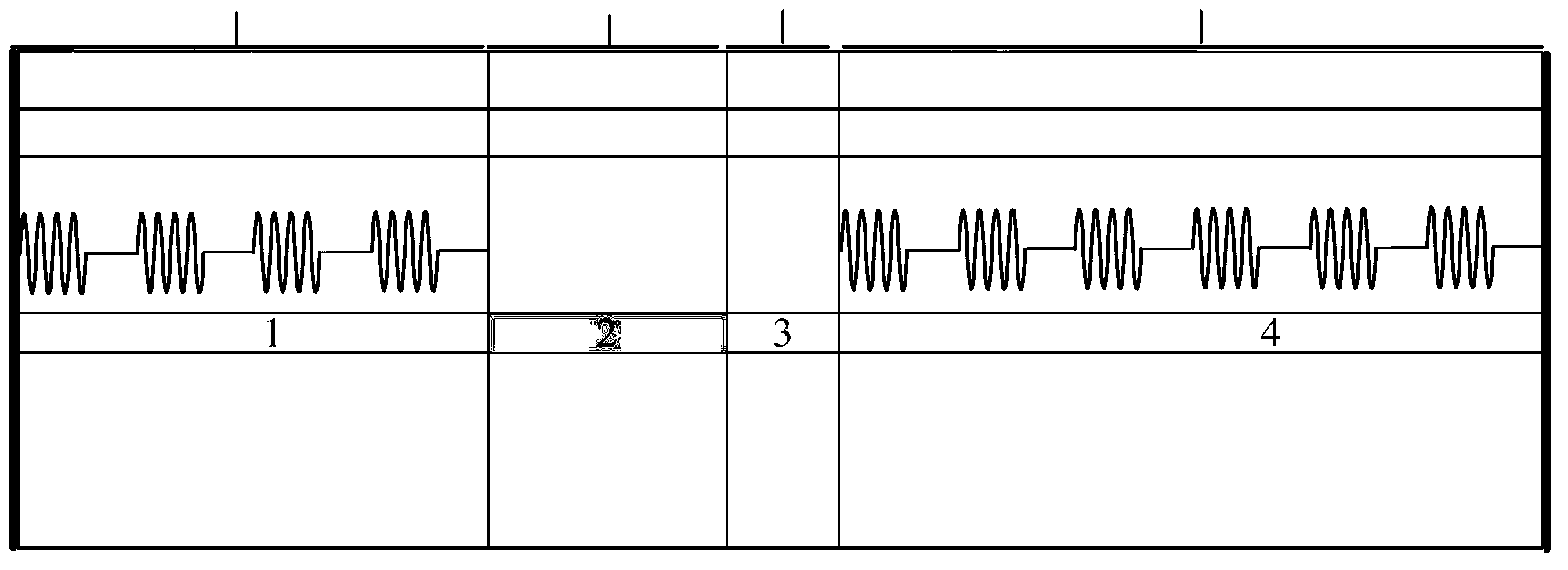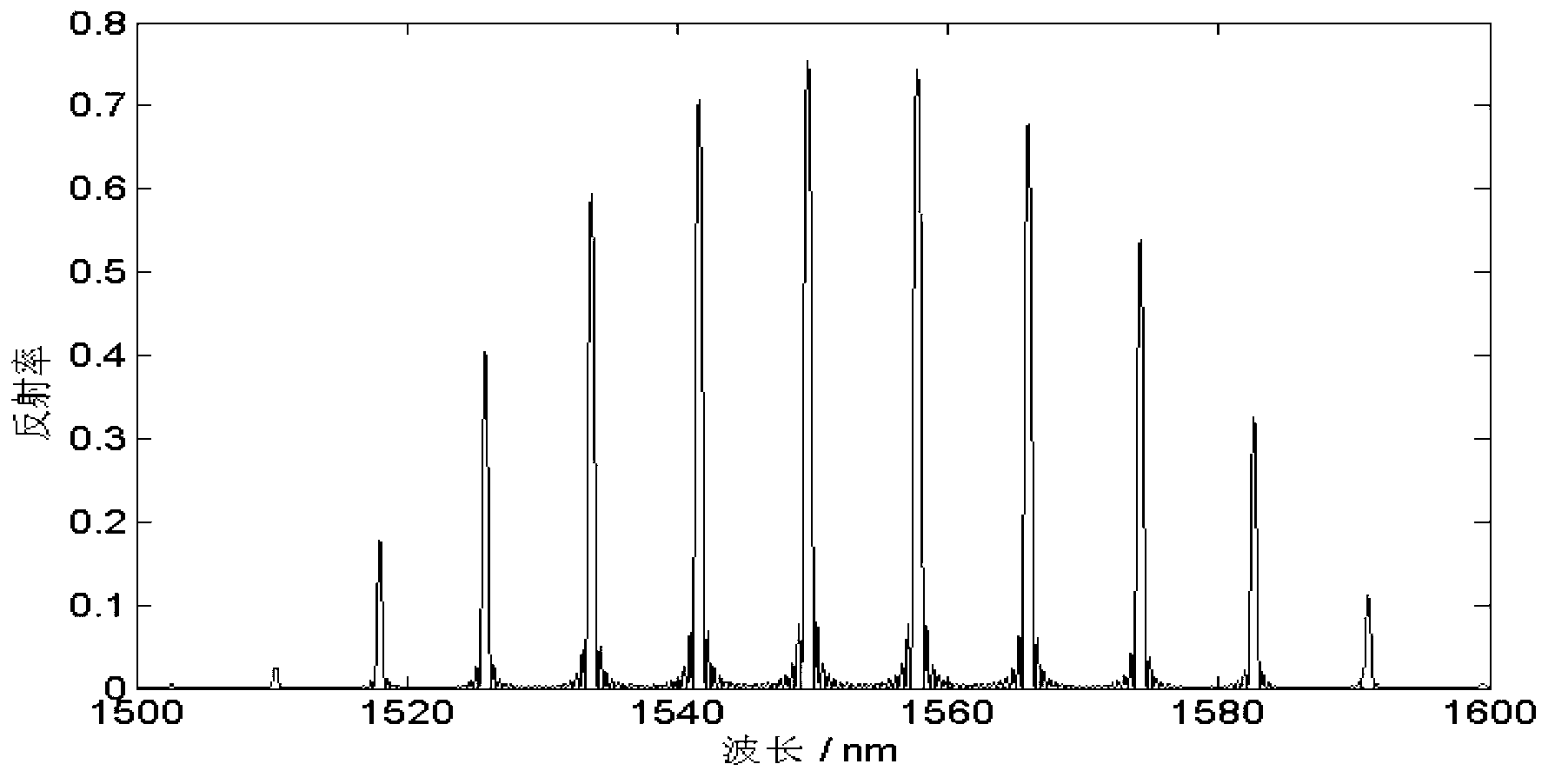Tunable semiconductor laser
A technology of lasers and semiconductors, applied in semiconductor lasers, lasers, laser components, etc., can solve problems such as inconsistent output optical power, achieve flat reflection peak response, ensure stability, and simple design of grating structure parameters
- Summary
- Abstract
- Description
- Claims
- Application Information
AI Technical Summary
Problems solved by technology
Method used
Image
Examples
Embodiment 1
[0075]In the first embodiment, the number of sub-segments of the front and rear multi-phase-shift digital cascaded Bragg gratings 9 and 10 is 3, and the multiplication factor of the number of channels is 2, that is, m=2, M=3, n=2, N=3. Figure 6 It is a structural schematic diagram of the front and rear multi-phase shift digital cascaded Bragg gratings in the first embodiment. For the front and rear multi-phase shift digital cascade Bragg gratings 9, 10, according to the formula φ kf =k×2π / m (pre-multi-phase shift digital cascaded Bragg grating 9) and φ kr =k×2π / n (post multi-phase shift digital cascaded Bragg grating 10), then the grating initial phase difference φ between the k+1 sampling period and the k sampling period kf with φ kr Both are kπ. The parameters used in the front and rear multi-phase shift digital cascaded Bragg gratings 9 and 10 are shown in Table 1 below. The effective refractive index n eff Choose 3.21.
[0076] Table 1: Structural parameter table of...
Embodiment 2
[0081] In the second embodiment, the number of sub-segments of the front and rear multi-phase-shift digital cascaded Bragg gratings 9 and 10 is 3, and the multiplication factor of the number of channels is 3, that is, m=3, M=3, n=3, N=3. Figure 11 It is a structural schematic diagram of the front and rear multi-phase shift digital cascaded Bragg gratings 9 and 10 in the second embodiment. For the front and rear multi-phase shift digital cascade Bragg gratings 9, 10, according to the formula φ kf =k×2π / m (pre-multi-phase shift digital cascaded Bragg grating 9) and φ kr =k×2π / n (post multi-phase shift digital cascaded Bragg grating 10), then the grating initial phase difference φ between the k+1 sampling period and the k sampling period kf with φ kr Both are k×2π / 3. The parameters used for the front and rear multi-phase shift digital cascaded Bragg gratings 9 and 10 are shown in Table 2 below. The effective refractive index n eff Choose 3.21.
[0082] Figure 12 and Fi...
Embodiment 3
[0087] In the third embodiment, the number of sub-segments of the front and rear multi-phase-shift digital cascaded Bragg gratings 9 and 10 is 4, and the multiplication factor of the number of channels is 2, that is, m=2, M=4, n=2, N=4. Figure 14 It is a schematic diagram of the structure of the front and rear multi-phase shift digital cascaded Bragg gratings in the third embodiment. For the front and rear multi-phase shift digital cascade Bragg gratings 9, 10, according to the formula φ kf =k×2π / m (pre-multi-phase shift digital cascaded Bragg grating 9) and φ kr =k×2π / n (post multi-phase shift digital cascaded Bragg grating 10), then the grating initial phase difference φ between the k+1 sampling period and the k sampling period kf with φ kr Both are kπ. The parameters used in the front and rear multi-phase shift digital cascaded Bragg gratings 9 and 10 are shown in Table 3 below. The effective refractive index n eff Choose 3.21.
[0088] Table 3: Structural parameter ...
PUM
 Login to View More
Login to View More Abstract
Description
Claims
Application Information
 Login to View More
Login to View More - R&D
- Intellectual Property
- Life Sciences
- Materials
- Tech Scout
- Unparalleled Data Quality
- Higher Quality Content
- 60% Fewer Hallucinations
Browse by: Latest US Patents, China's latest patents, Technical Efficacy Thesaurus, Application Domain, Technology Topic, Popular Technical Reports.
© 2025 PatSnap. All rights reserved.Legal|Privacy policy|Modern Slavery Act Transparency Statement|Sitemap|About US| Contact US: help@patsnap.com



